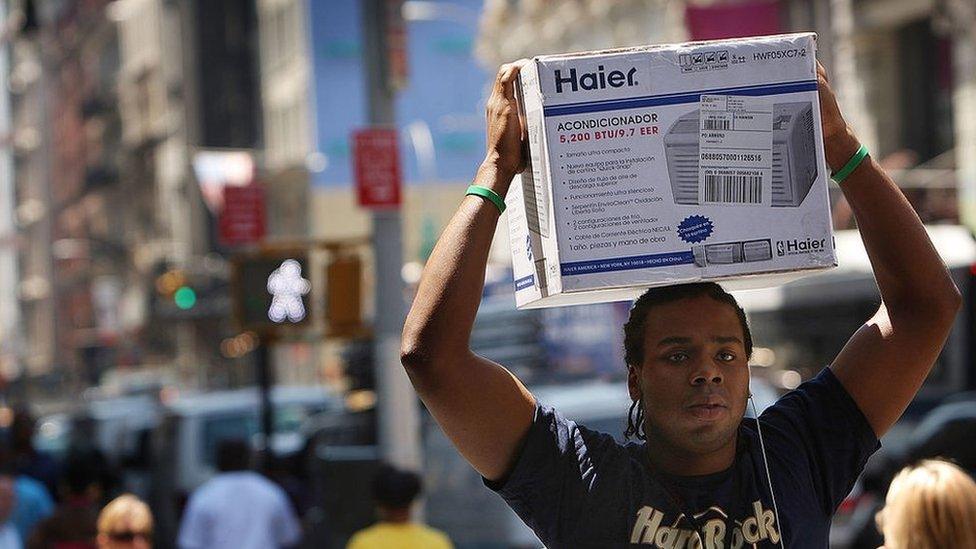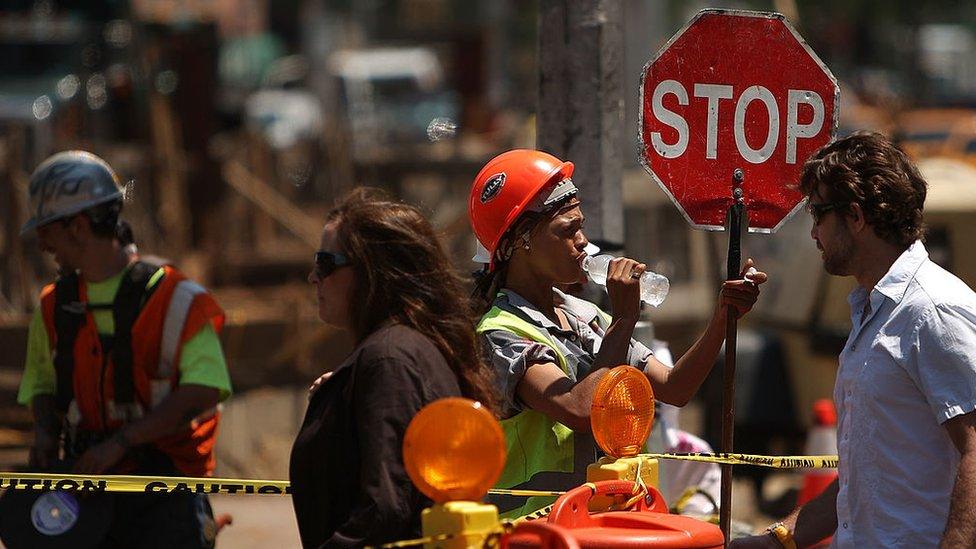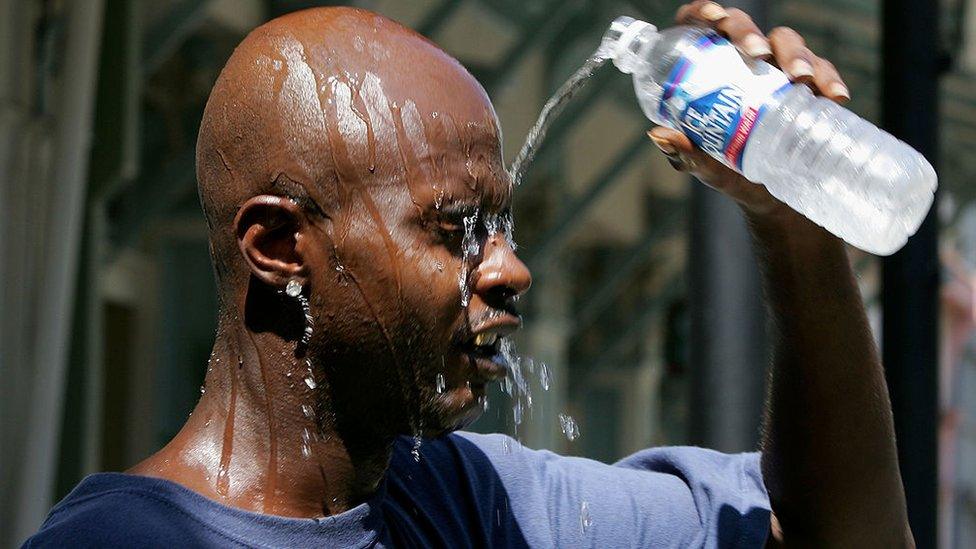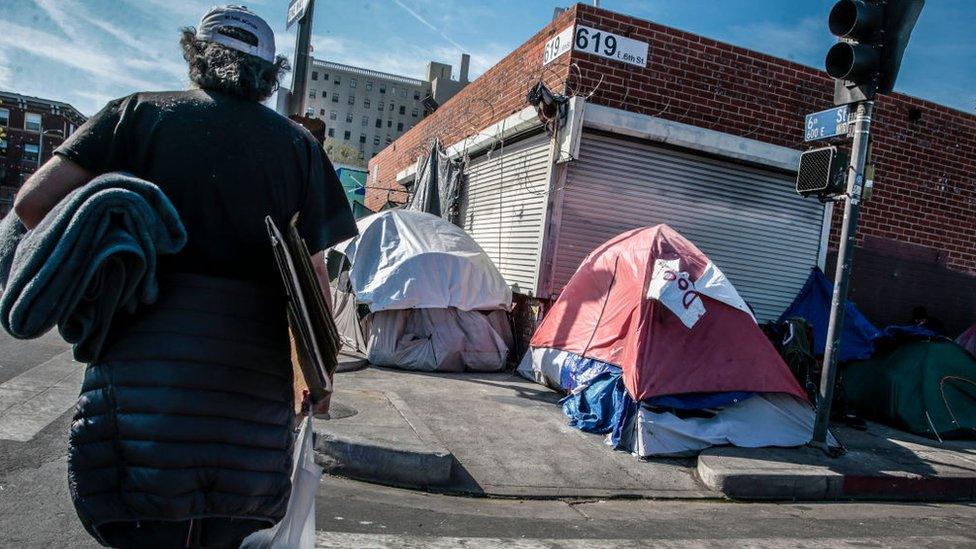Global heating: Study shows impact of 'climate racism' in US
- Published

A man carrying an air conditioner during a hot spell in New York
A new study says that black people living in most US cities are subject to double the level of heat stress as their white counterparts.
The researchers say the differences were not explained by poverty but by historic racism and segregation.
As a result, people of colour more generally, live in areas with fewer green spaces and more buildings and roads.
These exacerbate the impacts of rising temperatures and a changing climate.
Cities are well known magnifiers of a warmer climate.
The surface urban heat island effect, external is the technical term for the impact that the buildings, roads and infrastructure of cities have on temperatures.
All that concrete and asphalt attracts and stores more heat, ensuring that both days and nights in big urban areas are much warmer than the surrounding locations.
But, within cities, there are often large differences in this heat island impact, with areas rich in trees and green spaces noticeably cooler than those that are dense with housing and industry.

A heat wave in New York city
A previous study in the US, external found a correlation between warmer neighbourhoods in big cities with racist housing practices dating back to the 1930s.
Back then, areas with large African-American or immigrant populations were "redlined" in documents by federal officials, and deemed too hazardous for home loans and investment.
This led to a concentration of poverty and low home ownership rates in some parts of big cities.
This new study takes a broader look at these warmer neighbourhoods and the people who are affected by them.
Using satellite temperature data combined with demographic information from the US Census, the authors found that the average person of colour lives in an area with far higher summer daytime temperatures than non-Hispanic white people.
For the purposes of the paper, the scientists defined "people of colour" as including all Hispanic people (regardless of race) and anyone who does not identify as white alone.
In all but six of the 175 largest urbanised areas in the continental US, people of colour endure much greater heat impacts in summer.
For black people this was particularly stark. The researchers say they are exposed to an extra 3.12C of heating, on average, in urban neighbourhoods, compared to an extra 1.47C for white people.

A man in New Orleans impacted by a heatwave in the city
Exposure to heat not only leads to to increased mortality, it is also connected to a range of impacts including heat stroke, loss of productivity in work and impaired learning.
"Our study helps to provide more quantitative evidence that climate racism, environmental racism exists," said Dr Angel Hsu, from the University of North Carolina-Chapel Hill, the lead author of the paper.
"And it's not just an isolated incident, it's pervasive all across the United States."
While being poor was certainly a factor for exposure to increased urban heat in the summer, it didn't provide a full explanation.
In around half the cities, the average person of colour faced higher summertime heat than people living below the poverty line, even though just 10% of people of colour were classed as poor.
The root causes of these differences can be found in history, say experts.
"We can trace many of these present-day environmental, socioeconomic, and health inequities to explicit decisions and urban planning policies in the 20th century like 'redlining'," said Dr Jeremy Hoffman, the chief scientist at the Science Museum of Virginia, who was not involved in this new study.

Those in poverty and the homeless also suffer badly from urban heat exposure
"While money doesn't grow on trees, it is clearly located in the neighbourhoods under them, especially in the US."
With temperatures likely to increase due to global heating over the coming decades, this is a problem that is likely to get worse without significant input from state and federal government, as President Biden has promised, external.
Solutions, though, need to be carefully thought out.
In the paper, the authors reflect on the fact that planting trees in heat-stressed areas can reduce summer temperatures by 1.5C, which is good for residents.
But the new trees can also increase property values and these house price effects can end up displacing the minority residents the policies were designed to help.
"As our society emerges from the pandemic, which showed that these very same communities that are hotter during the summer are also those suffering the largest impacts from Covid-19, it's essential that we ensure we are centring them in our recovery," said Dr Hoffman.
"But, if decisions are made for these neighbourhoods without the intentional input and guidance of the citizens who live there, it's not any better in theory than the practice of redlining or any other nefarious planning process in the past."
The study has been published, external in the journal Nature Communications.
Follow Matt on Twitter., external